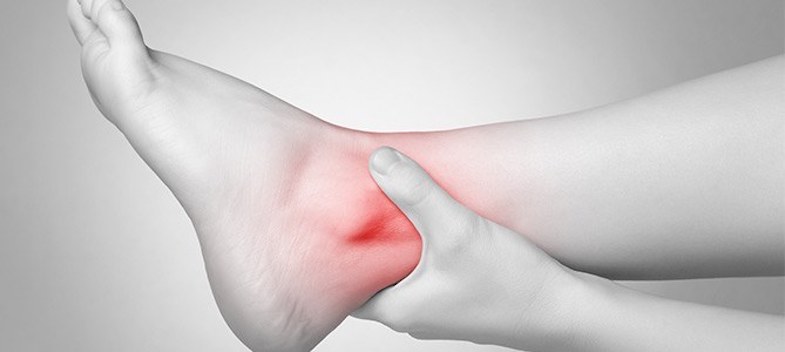Achilles Tendonitis
Whether you are a professional athlete or a weekend warrior out catching a few passes with a group of friends, Achilles tendonitis can literally stop you in your tracks. It can have a debilitating and worsening effect on your daily life. If you’re suffering from ankle pain, this is what you need to know.
What is Achilles tendonitis?
Your Achilles tendon attaches the calf muscle to the heel bone. It’s the tendon that makes running and walking possible. Achilles tendonitis, though, is an overuse injury of this tendon that leads to inflammation and irritation.
An injury to the Achilles can be mild, requiring only rest and over-the-counter anti-inflammatory drugs, or severe, necessitating surgical repair of the damaged tendon. In addition, chronic Achilles tendonitis can lead to micro tears in the tissue (tendinosis) that weaken the tendon and put it at risk for severe damage, such as a tear or rupture.
What are the common causes of Achilles tendonitis?
Inflammation of the Achilles tendon is most often the result of repeated movements associated with physical exercise. Strenuous exercise, jumping, and climbing are all movements that can strain the tendon and your calf muscles.
Other possible causes of Achilles tendonitis include:
- Implementing a new exercise regimen, such as running uphill or climbing stairs
- Changing an exercise routine too quickly (e.g., boosting intensity and increasing duration suddenly)
- Wearing unsupportive exercise shoes with worn-out soles or poor design
- Neglecting to warm up prior to strenuous exercise
- Running on a hard or uneven surface
- Suffering from a deformation in the foot such as a flat arch, or any anatomical variation that puts unnecessary strain on your Achilles tendon
Do I have Achilles tendonitis?
Achilles tendonitis symptoms may first appear as mild to severe pain or swelling near your ankle. This pain may lead to weakness and decreased mobility. Symptoms may also increase gradually while walking or running.
Over time and left untreated, the pain worsens. Stiffness in your tendon may be most intense in the morning after the tendon has been inactive for a long period.
In severe cases, a ruptured or torn Achilles tendon can occur. This is incredibly painful and warrants immediate medical attention. The signs of a ruptured or torn Achilles tendon include:
- Acute, excruciating pain
- Impaired mobility
- Inability to point the foot downward, bear weight on the affected side, or walk on the toes
How does a doctor diagnose this condition?
To diagnose Achilles tendonitis, your doctor will conduct a thorough physical exam, checking for pain and swelling along the back of your leg or any signs of weakness in the lower leg. The physical exam may reveal an audible cracking sound when palpating the Achilles tendon.
Your doctor will also take a complete patient history. This will include questions about:
- When your pain started
- Possible triggering events (i.e., injury or any of the factors above)
- The quality of your pain (intensity and duration)
- Daily onset (Is it worse in the morning? After work?)
- Description of pain and weakness
For a formal diagnosis, your doctor may also look at your muscles, tissues, bones, and blood vessels with imaging studies, such as X-ray, ultrasound, or MRI.
12 Achilles tendonitis treatments
For cases of Achilles tendonitis that range from mild to severe, the first-line treatment is the same: gentle rest. Tendons take a while to heal, and rest gives the swelling and pain a chance to recede.
Once approved by your doctor, here are other Achilles tendonitis treatments to try.
- Stretching exercises: These increase flexibility and allow the tendon to heal without shortening, an anatomical change that can result in chronic pain
- Non-prescription medications: Non-steroidal anti-inflammatories like ibuprofen can reduce pain and inflammation
- Mild activity: Brief walks on level ground or on a treadmill increases blood flow to promote healing
- Cold therapy for inflammation: Follow a 20 minutes on, and 20 minutes off schedule with an ice pack to relieve pain and swelling
- Change sleeping position: Sleeping with the affected foot propped up on a pillow can relieve swelling
- Massage therapy: Massage improves blood flow to the muscles and tissues of the affected area while increasing range of motion
- Ultrasound heat therapy: The healing process may be quickened using ultrasound heat therapy to improve blood flow to the affected area
- Night braces: Wearing a night brace keeps your foot flexed, preventing stiffening of the tendon
- Walking boot or cast: Persistent Achilles tendonitis may warrant the use of a cast or walking boot to stabilize the tendon so it can heal
- Physical therapy: Especially after a walking boot or cast, physical therapy can improve mobility in your Achilles tendon
- Corticosteroid injections: These may reduce chronic inflammation of the tendon, but it’s important to note that this treatment increases the risk of tendon rupture especially when you get multiple done in a short period of time
- Surgery: When all other therapies have failed or tendon rupture occurs, surgical intervention and repair of the muscles and tendons is the last treatment option
